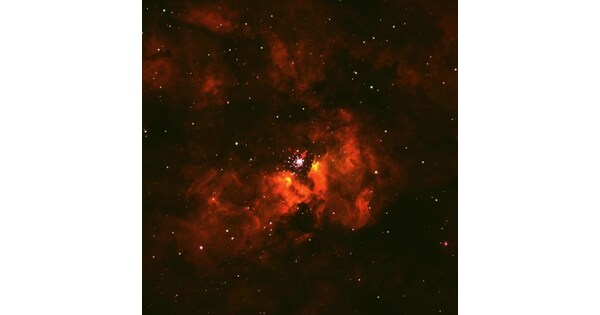The binary star system NGC 3603-A1 is one of the most massive binaries ever discovered in the Milky Way Galaxy.
FLAGSTAFF, Ariz., Aug. 22, 2025 /PRNewswire/ — A team of astronomers led by Dr. Phil Massey of Lowell Observatory has taken the sharpest look yet at one of the heaviest pairs of stars in our galaxy, known as NGC 3603-A1. Using previously unpublished archival data from the Hubble Space Telescope (HST) and new, precisely timed observations, the team measured the properties of this extraordinary system at a level never before achieved. The study will soon be published in The Astrophysical Journal.
The region around NGC 3603 is surrounded by ionized hydrogen gas, shown in red. The star A1 is located in the central cluster of stars. Credit: This image was taken by N. Morrell, K. Farrell using the Las Campanas 1-meter telescope, and processed by P. Massey.
NGC 3603-A1 is located in a dazzling cluster of stars known as NGC 3603, located some 25,000 light-years from Earth. This region is one of the most active star-forming areas in our galaxy and is home to dozens of extremely hot and bright stars.
The two giant stars that make up the NGC 3603-A1 system orbit each other once every 3.8 days. This means that in the time it takes Earth to orbit the Sun one time, the two giant stars that make up the NGC 3603-A1 system will have orbited each other nearly one hundred times. One star is about 93 times the mass of our Sun, and the other is about 70 times as massive. These stars are so bright and powerful that they release intense winds and radiation, making them look like a special type of star called a Wolf-Rayet star. A Wolf-Rayet star is an extremely hot, massive star nearing the end of its life, blasting powerful winds that strip away its outer layers and make it shine with unusual intensity. Unlike true Wolf-Rayet stars, however, the stars in NGC 3603-A1 are still young.
“This is a rare and exciting find,” said Massey. “These stars are among the heaviest we’ve ever measured directly in our Milky Galaxy, and they help us understand how massive stars live, evolve, and eventually die.”
Although astronomers had long suspected that NGC3603-A1 was a very massive binary star system, this is the first time that these heavyweights have been directly measured. Sarah Bodansky, then an undergraduate student at Carleton College, worked remotely at Lowell Observatory during the “pandemic summer” of 2020, and identified the key way forward from the older Hubble data.
“For the most massive stars, astronomers usually have to rely on models that aren’t very well-constrained to “weigh” the star,” said Bodansky, “but this study focused on a special type of binary system where we can get a more fundamental measurement of its mass.”
“Sarah’s work made it possible to move this project forward,” Massey said. “She noticed something that everyone had missed: some of the spectral features doubled when the stars had their greatest motions towards and away from us. Without this discovery, the project would have languished.”
The discovery was made possible by carefully analyzing both new and old data from HST. By studying how the stars orbit each other and how their light changes over time, the team was able to figure out their sizes, temperatures, and how they interact with each other.
Interestingly, the smaller star in the pair seems to have siphoned mass from its larger companion, spinning faster as a result. This kind of interaction is important for understanding how stars change over time, and how they might eventually explode or collapse into black holes.
Massive stars like these are also key players in the cosmic drama of gravitational waves, the ripples in space-time first detected in 2015. Massive binary stars like this can become binary black holes, which can then merge, creating these waves which scientists now use to explore the universe in entirely new ways.
This discovery adds a vital piece to the puzzle of how stars shape the universe, and it all started with a closer look at a “fuzzy” star in one of the galaxy’s most dazzling neighborhoods. Because the stars there are packed so tightly together, only the Hubble Space Telescope could untangle the view.
In addition to Massey, other members of the team include Sarah Bodansky, now a Ph.D. student at University of Massachusetts, Amherst; Laura Penny, College of Charleston; Nidia Morrell, Las Campanas Observatory; and Kathryn Neugent, Lowell Observatory.
About Lowell Observatory
Founded in 1894, Lowell Observatory in Flagstaff, Arizona, is a renowned nonprofit research institution. It is the site of historic and groundbreaking discoveries, including the first evidence of the expanding universe and the discovery of Pluto. Today, Lowell’s astronomers utilize global ground-based and space telescopes, along with NASA spacecraft, for diverse astronomical and planetary science research. The observatory hosts more than 100,000 visitors annually for educational tours, presentations, and telescope viewing through a suite of world-class public telescopes.
SOURCE Lowell Observatory
